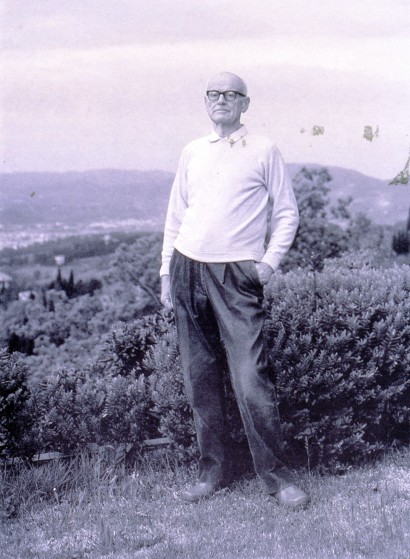PIETRO PORCINAI – Landscape Designer

Florence, 1910 – 1986)
Pietro Porcinai was born in Settignano near Florence and was the son of Martino, the chief gardener of Princess Ghika who was the owner of the famous La Gamberaia villa in Settignano. From the years of his early childhood he became passionate about the art of garden landscaping. In 1928-1929 he went to Bruxelles to study the practice of garden landscaping and green spaces design at the Daprs greenhouse.
The following year Gio Ponti invited him to collaborate with Domus magazine. After he graduated from the Lyceum of Arts in 1935, he met and frequented the best landscape designers of the time such as Gerda Gollwitzer, Henry Cocker, Russel Page and Geoffrey Jellicoe.
In 1982 he promoted a committee for the writing of The Italian Chart for Historical Gardens, which is still nowadays a Decalogue for interventions in historical gardens. Porcinai liked to say: «The private garden must not be considered a luxury because every tree…is functional to our life». From the 1950s on he made frequent interventions to decorate the production areas of the main Italian companies – 45 in all – from Olivetti to Marzotto, to Mondadori of Segrate, to Pirelli, Althea, Farmitalia, and Zegna.
He also designed the park of the beautiful Villa Barilla in Fraore, projected in 1957 by Luigi Vietti (1903-199) for Pietro and is family. The encounter was profitable and Porcinai was called again by Pietro Barilla in 1960 to design the green space of the small area that is in front of the Parma factory and is visible from the Via Emilia, and to enrich it with a few precious wood essences (Pterocarya Fraxinifolia, Fagus silvatica purpurea, Liriodendron Tulipifera), to compliment the new light colored and transparent facade designed by Gian Luigi Giordani (1909-1977). After Pietro returned to conduct the company, in 1982 Porcinai proposed the planting of a wood of deciduous trees along the Autostrada del Sole highway, along the northern side of the Pedrignano plant, and proposed to populate the fauna with chicken, as a symbol of the company’s industrious character. The idea was not developed, but Porcinai was called to redesign the green areas around the plant and the silos and offices. In his long career as a landscape architect which lasted 60 years, Porcinai worked on projects in the whole world designing parks, gardens, industrial areas, highways and sport centers. To this fervent activity, he was able to also combine a multifaceted series of interventions and innovations, from the patent for children’s diapers of 1947, to the intervention to save the Abu Simbel temples in Egypt from the waters of the River Nile (1963-1971) to a system to divide traffic lanes on highways with space to contain shrubberies or vegetation elements in 1967. In recognition of his professional achievements he received numerous prizes during the course of his career, like the Award of Merit of the School of Environmental Designof the University of Georgia an an award from the Fine Art Academy of Bavaria, for the first time given to a non German artist. In 1999 the Provincial Council of Florence dedicated to his memory a hall of Villa Demidoff, naming him as the greatest Italian Landscape Architect of the century, even though he never graduated in Architecture, and a founding father of this art.
Cecilia Farinelli
Bibliography
POZZANA M., Pietro Porcinai architetto del giardino e del paesaggio (Pietro Porcinai, an architect of gardens and landscape), in Flortecnica, 1987, April.
MATTEINI Milena, Pietro Porcinai architetto del giardino e del paesaggio (Pietro Porcinai, an architect of gardens and landscape). Milan, Electa, 1991.